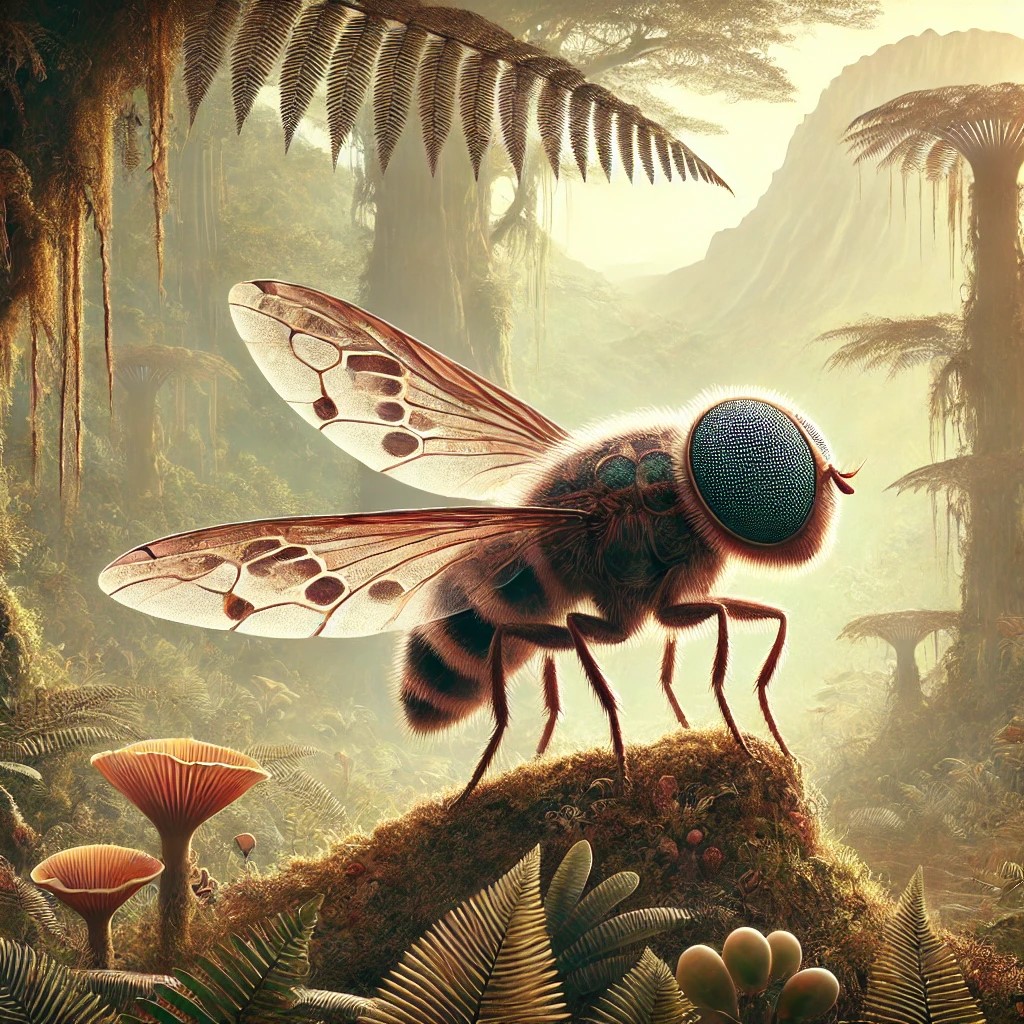
Flies have witnessed the evolution of our planet for more than 250 million years. Their incredible ability to adapt and diversify has made them one of the most successful insect groups, with a presence in virtually all ecosystems. From their emergence in the age of dinosaurs to their modern roles as pollinators, decomposers, and, in some cases, disease vectors, their evolution has been key to maintaining ecological balance.
Origins: From the First Flying Insects to Modern Flies
Flies belong to the order Diptera, which originated during the Triassic period, approximately 250 million years ago. It is believed that they evolved from primitive insects similar to winged scorpions (Mecoptera), which were among the first organisms to develop the ability to fly.
During the Jurassic period (around 200 million years ago), the ancestors of modern flies began to specialize in different feeding habits, ranging from consuming nectar to decomposing organic matter. This allowed the group to diversify into different families and expand into various ecosystems.
Over time, their anatomical structure evolved, optimizing their flight by reducing their second pair of wings into stabilizing structures called halteres, one of their most distinctive features. This innovation gave them unique aerial maneuverability, making them experts in quick and evasive movements.
The Great Diversification of the Diptera Order
The order Diptera is currently one of the most diverse groups of insects, with over 150,000 described species and many more yet to be discovered. This diversity has allowed flies to specialize in different ecological niches, playing key roles in nature.
Some of the main fly families include:
🔹 Muscidae (Musca domestica, housefly): Adapted to urban and rural habitats, they have become one of the most common species associated with human activity.
🔹 Calliphoridae (blowflies and bluebottle flies): These flies are essential for decomposing carcasses and have been widely used in forensic entomology, helping to determine the time of death in criminal investigations.
🔹 Syrphidae (hoverflies): Active pollinators that play a role similar to that of bees, transporting pollen while feeding on nectar.
🔹 Tachinidae: A group of parasitoid flies that help regulate pest insect populations in agriculture.
Key Adaptations for Their Evolutionary Success
The reason flies have survived and thrived for millions of years lies in their adaptability. Some of their most remarkable evolutionary traits include:
🔹 Short life cycle and high reproductive rate: Many species can complete their life cycle in just a few days, allowing them to rapidly colonize new habitats.
🔹 Efficient flight: Thanks to their halteres and lightweight bodies, flies have exceptional aerodynamic control, enabling them to make quick maneuvers to evade predators.
🔹 Specialized feeding strategies: Over time, they have developed specialized mouthparts adapted to different food sources, from nectar to blood and decomposing matter.
🔹 Resistance to extreme environments: Some fly species have been found in harsh habitats such as hot springs, Arctic regions, and even crude oil, demonstrating their incredible ecological flexibility.
Their Impact on the Ecosystem and Science
Beyond their ecological importance, flies have played a crucial role in the advancement of genetics and evolutionary biology.
One of the most studied species is the fruit fly (Drosophila melanogaster), which has been used in laboratories since the 20th century due to its short life cycle and genetic similarities to humans. Thanks to its study, scientists have made significant discoveries in genetics, evolution, and biotechnology.
Additionally, their environmental impact is undeniable. As decomposers, they help eliminate organic waste and recycle nutrients in the soil. As pollinators, they contribute to plant regeneration. And as a link in the food chain, they serve as food for birds, reptiles, and other insects.
From their origin in the Triassic period to their present-day presence, flies have proven to be one of the most successful and resilient insect groups on the planet. Their diversity, adaptability, and ecological role make them essential organisms for maintaining ecosystem balance.
However, their success has also created challenges in urban environments, where some species have become vectors of diseases. Therefore, understanding their evolution and impact allows us to develop responsible management strategies to control their presence without disrupting their ecological function.
At Eco Fauna Control, we understand the importance of flies in nature, but we are also aware of the risks they pose in urban, commercial, and industrial environments. That is why we offer responsible and sustainable pest control solutions, tailored to each specific need.
🔹 Professional diagnosis: We identify the type of fly present and design personalized management strategies.
🔹 Safe and efficient methods: We apply innovative techniques that minimize the use of chemicals, protecting human health and the environment.
🔹 Prevention and control: We implement long-term measures to prevent fly infestations and reduce health risks.
If you need assistance with fly control or any other pest issue, contact us.
